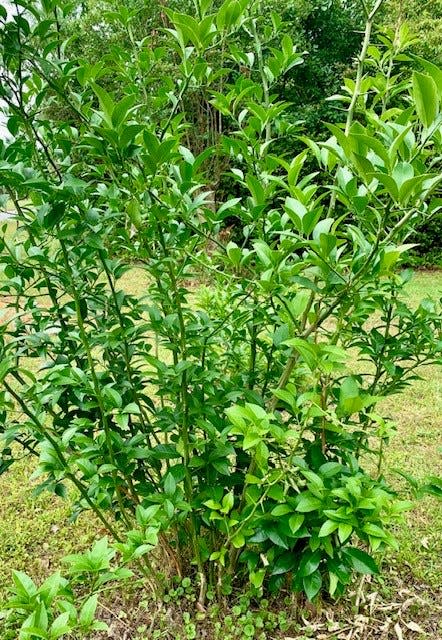False hope for cold-damaged citrus trees | Gardening

The widespread multiple-night hard freeze that occurred in North Florida near the end of December 2022 resulted in numerous citrus trees becoming severely damaged. The above-ground portion of many of these trees died as a result of the extreme cold.
I talked with numerous homeowners who were concerned about their citrus trees following that weather event. Many of these homeowners earnestly and hopefully watched for any sign of new growth on their cold-injured citrus trees the following spring. When new growth appeared from the lower portion of the trunk and from the roots, the homeowner became excited with a false sense of hope that their citrus tree had survived and would again produce an abundance of desirable fruit.
Now, in the spring of 2024, many of these citrus trees have somewhat regrown from those root shoots, not from the completely dead tops. In most cases, the freeze-damaged, dead tops of the once large trees have now been pruned away to allow the multitude of small-diameter, vigorous green shoots to grow.
Most purchased citrus trees are grafted. So, what survived and is now regrowing is coming from the rootstock, not from the original, desirable, edible-fruit-producing top. That desirable top was completely killed.
To better understand this scenario, perhaps a basic definition of grafting will help. This definition was taken from a University of Missouri Extension publication on grafting. “Grafting is the act of joining two plants together. The upper part of the graft (the scion) becomes the top of the plant, the lower portion (the understock) becomes the root system or part of the trunk.” Understock also is known as rootstock.
Grafting involves joining two different individuals. These individuals have to be closely related. For example, citrus can be grafted to other types of citrus, and peaches can be grafted to other types of peaches, but citrus cannot be grafted to peaches.
The rootstock was selected because of some beneficial trait(s): resistant to a root pest, superior cold-hardiness, imparts a dwarf-growth habit to the top, etc. But, the same rootstock produces undesirable fruit: bitter, hard, extremely seedy, etc. The top (scion) was selected because of a superior fruit: sweeter, bigger, more disease-resistant, etc. But, the same scion produces an inferior/weak root system. So, grafting the two together allows for the “best of both worlds.”
When all that is left is originating at or below the graft union or rootstock, the eventual resulting fruit will usually be undesirable, and sometimes not edible.
So, unfortunately, the best option in this scenario is to start over with another healthy grafted tree that is well-suited for the potential cold weather of North Florida.
This article originally appeared on The Gainesville Sun: False hope for cold-damaged citrus trees | Gardening
